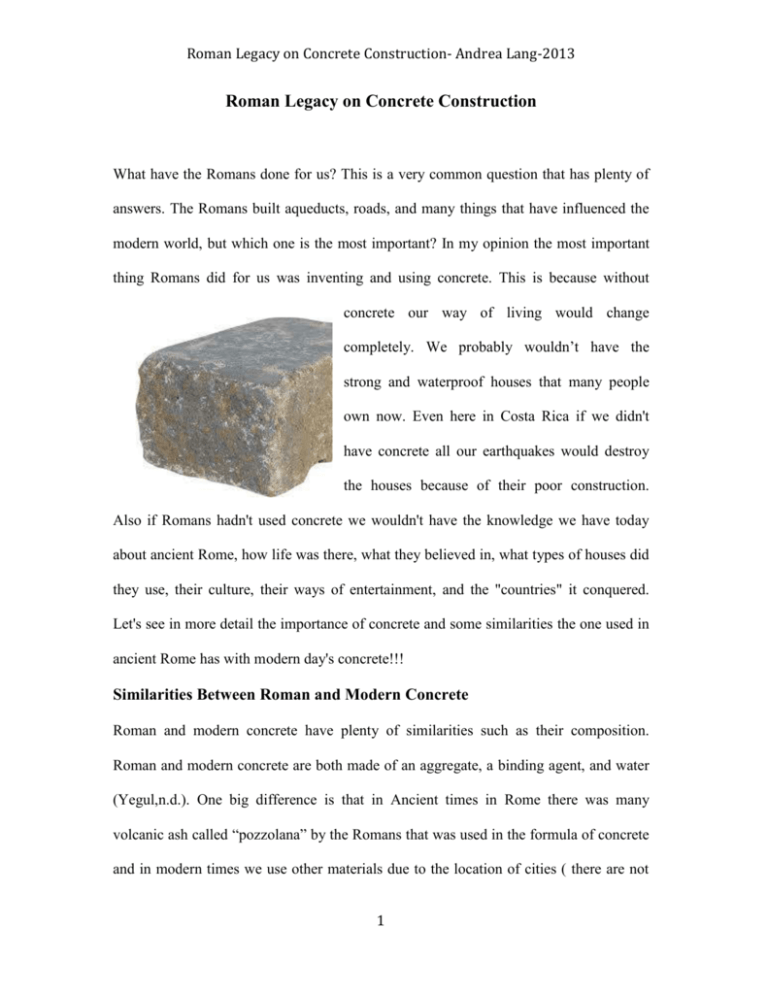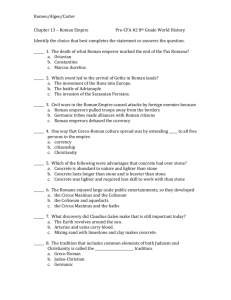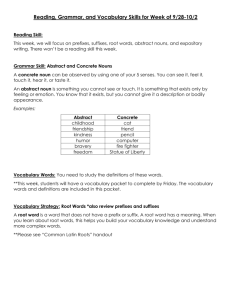Roman Concrete Legacy - Andrea
advertisement

Roman Legacy on Concrete Construction- Andrea Lang-2013 Roman Legacy on Concrete Construction What have the Romans done for us? This is a very common question that has plenty of answers. The Romans built aqueducts, roads, and many things that have influenced the modern world, but which one is the most important? In my opinion the most important thing Romans did for us was inventing and using concrete. This is because without concrete our way of living would change completely. We probably wouldn’t have the strong and waterproof houses that many people own now. Even here in Costa Rica if we didn't have concrete all our earthquakes would destroy the houses because of their poor construction. Also if Romans hadn't used concrete we wouldn't have the knowledge we have today about ancient Rome, how life was there, what they believed in, what types of houses did they use, their culture, their ways of entertainment, and the "countries" it conquered. Let's see in more detail the importance of concrete and some similarities the one used in ancient Rome has with modern day's concrete!!! Similarities Between Roman and Modern Concrete Roman and modern concrete have plenty of similarities such as their composition. Roman and modern concrete are both made of an aggregate, a binding agent, and water (Yegul,n.d.). One big difference is that in Ancient times in Rome there was many volcanic ash called “pozzolana” by the Romans that was used in the formula of concrete and in modern times we use other materials due to the location of cities ( there are not 1 many near a volcano and concrete is not made by hand) (Dr. Dig., n.d.). Also their uses are still very much the same. For example in Roman times they used concrete to build houses, buildings, and temples and in modern days we still use it for houses, buildings, and different temples from different religions such as Churches and Synagogues. Is Roman concrete hard? Is Roman concrete hard? The answer to this easy but important question is yes. Roman concrete is one of the hardest materials used for construction. This is the reason why we can still see it today in Rome’s ruins.( The Colloseum, the aqueducts, etc.) Roman concrete is so hard that you can try to scratch it or try to get a little pebble to fall and it would be almost impossible. (Roman Concrete, 2008) What material leaded to the invention of concrete? What material leaded to the invention of concrete? This question is not so important but it is a very interesting fact. “At first the Romans used lime like everyone else. Then, at a time that must have been around the second century BC, they began to make walls by pouring the lime, sand, fine stones (aggregate), and water mixture into molds: concrete”( Roman Concrete, 2008) Advantages of Roman and Modern Concrete Roman concrete had many advantages that are responsible of making it so common and popular in ancient and modern times. One of these advantages is its cost. From articles in the Internet you can learn that one of the reasons concrete was and is so famous and used is because of its really low cost. Another advantage that made concrete so popular in modern and ancient times is that in ancient times concrete was really resistent and waterproof and those qualities helped the Romans have a much easier life and in 2 Roman Legacy on Concrete Construction- Andrea Lang-2013 modern days we discovered those qualities that helped the Romans and started using the same material –concrete- to construct. Also in ancient and modern times concrete is and was really easy to get. In modern times you can get it in every construction store (in Costa Rica you can get it even in EPA or Constru Plaza). In ancient times the formula was well known and the materials were really easy to get. How has concrete influenced modern life? How has concrete influenced modern life? This question should come to mind when you think about the word ''legacy'' (in the title). Concrete is one of the most influential things the Romans made and perfectioned for us. Starting from a house/building made of concrete that can protect you from many natural disasters like earthquakes, hurricanes, tornadoes, sand storms, snow storms, etc. Then also a house/building made from concrete can protect you from rain, thunder and lightning, wind, and other extreme or hazardous climates. A very important thing concrete houses/ buildings can give us is protection against skin cancer by blocking the UV rays that the Sun sends to Earth better than wood making the chances of dying of skin cancer decrease. Another really great thing concrete houses/buildings give us is very good protection against thieves and a strong place to store all our things. Finally, concrete makes our houses more resistant and also makes them pretty. Is this all Romans made by creating concrete? 3 Maybe you are asking yourself: Is this all Romans made by creating concrete? The answer to that question is NO. Lots of Roman structures stand today thanks to the use of concrete but, how does this help us? This helps us because thanks to such standing buildings, archeologists have discovered many things about Rome and how life was there. Also archeologists have revived many ideas by studying the structures/buildings that they found and making a modern version of them like ancient aqueducts and modern aqueducts, and even concrete was lost and then revived because of those ancient buildings (Kanud, January). Also ancient Roman structures provide a spectacular destination for tourists and an important academic traveling opportunity. That helps Italy's economy a-lot because tourists have to get tour guides, hotels, airplane tickets, transportation, attraction tickets, and food and by that they pay locals and leave some money in the country. That money can be used either to help poor or just normal people live a great life and also it could help the government make some innovations with it because the tickets for national parks are usually paid to the government. Roman Sculptures Influence in Modern Life and Relationship with Concrete Many ancient Roman sculptures were made of concrete, bronze, and marble (Caroline M, n.d.). Thanks to these strong materials many of them still exist today and decorate public places and museums all over the world. This makes people from different countries become more familiar with Rome and its history connecting us and giving us the ability to improve what the Ancient Romans made for us. Also in some museums they allow you to almost touch them and that makes you imagine what were they made for and how they were made. Was it easy to build with concrete? 4 Roman Legacy on Concrete Construction- Andrea Lang-2013 By this section of the paper you should be asking yourself: Was Roman concrete an easy material to build with? was it flexible? Yes, concrete was an easy material to build with because "Concrete had greater flexibility in molding space since concrete was virtually poured (or layered) into a formwork and took the shape of its container “(Yegul, n.d.). This was one really useful and practical technique used by only the Roman Empire and it really helped during the construction of any buildings like houses, the Pantheon, and the Colosseum. Conclusion Concrete is one of the most important innovations the Romans brought to us. It has improved our way of living in a many important ways. All its benefits, such as flexibility and easiness to build, its low cost and facility to get, and its hardness and resistance to water that made it so important and popular in modern and ancient times. Also concrete influenced modern life in a huge quantity by protecting people from weather and other natural disasters better than most of the differently constructed houses do; also a house built with it makes a good and strong place to store things and protect them from thieves, and a house built with concrete is going to be more hygienic than one constructed with wood because wood deteriorates and grows mold and fungus. Also our understanding of Rome and Ancient Times wouldn't be the same without concrete because many of its structures built with this material survived all the periods and moments of destruction that the Roman republic and empire had. This material called "Opus caementicium" (Yegul, n.d.) by the Romans was created during the period of Pax Romana because they had lots of peace and time to create things such as aqueducts, concrete, and also in that time they built the colosseum, and many other famous Roman 5 buildings. (Jenkins, n.d.). Thanks to this material our way of living and our health has improved a-lot and we owe all of it to the Romans. 6 Roman Legacy on Concrete Construction- Andrea Lang-2013 Bibliography Andrews, Evan. "10 Innovations That Built Ancient Rome." History.com. A&E Television Networks, 20 Nov. 2012. Web. 23 May 2013. <http://www.history.com/news/history-lists/10-innovations-that-built-ancientRome>. Dig, Dr. "Roman Concrete." Roman Concrete. Ask Dr.dig, n.d. Web. 26 May 2013. <http://www.digonsite.com/drdig/greece/5.html>. Falchetto, Augusto C. "THE SECRETS OF ROMAN CONCRETE."Http://personal.ce.umn.edu/. N.p., n.d. Web. 26 May 2013. <http://personal.ce.umn.edu/~ballarin/assets/docs/%20pdf/ce%204011%20ancie nt%20and%20modern%20structures%20in%20italy/Roman%20concrete/Roman %20concrete.pdf>. Herring, Benjamin. "THE SECRETS OF ROMAN CONCRETE." Romanconcrete. CONSTRUCTOR, --- Sept. 2002. Web. 23 May 2013. <http://www.Romanconcrete.com/Article1Secrets.pdf>. Jenkins, Lyndsey. "The Influential Innovation of Roman Concrete." Docs.google. Docs.google, n.d. Web. 23 May 2013. <https://docs.google.com/document/preview?hgd=1&id=1psj2t6Sm9fl3kOZDi MkMXL8Obe689GBgaVnOmoQbzKg&pli=1>. 7 Johnsinit. "What the Romans Taught Us about Concrete." Brighthub Engineering. Lamar Stonecypher, 23 July 2010. Web. 23 May 2013. <http://www.brighthubengineering.com/concrete-technology/78929-Romanconcrete-technology/>. Larsh, Victoria. "The Legacy of Rome and the Western Civilization." The Legacy of Rome and the Western Civilization. Mr.Hotte, 30 Apr. 2010. Web. 23 May 2013. <http://es.scribd.com/doc/30869457/The-Legacy-of-Rome-and-the-WesternCivilization>. M, Caroline. "Art and Architecture - Ancient Rome Civilization." Ancient Rome Civilization. Weebly.com, n.d. Web. 24 May 2013. <http://ancientRome5thhour.weebly.com/art-and-architecture.html>. Moore, David. "The Riddle of Ancient Roman Concrete." , David Moore, PE. Central Texas College, 1999. Web. 26 May 2013. <http://www.Romanconcrete.com/docs/spillway/spillway.htm>. N.a. "Roman Concrete | Great Names in History." Great Names in History. Wordpress.com, 4 Feb. 2008. Web. 30 May 2013. <http://100falcons.wordpress.com/2008/02/04/Roman-concrete/> 8 Roman Legacy on Concrete Construction- Andrea Lang-2013 Yegul, Fikret. "ROMAN CONCRETE." ROMAN CONCRETE. University of California, Santa Barbara, no date. Web. 23 May 2013. <http://archserve.id.ucsb.edu/courses/arthistory/152k/concrete.htm Photo Credits N.p. Craik-Patton House. N.d. Photograph. Charleston, West Virginia, United States.Craik Patton House. Touristlink.com. Web. 30 May 2013. <http://es.touristlink.com/Estados-Unidos/craik-patton-house.html>. N.p. Stretcher Cap. n.d. Photograph. Roman Pisa. Roman Pisa. Pavers by Ideal. Web. 30 May 2013. <http://www.idealconcreteblock.com/productdetails/items/roman-pisa.html>. 9







